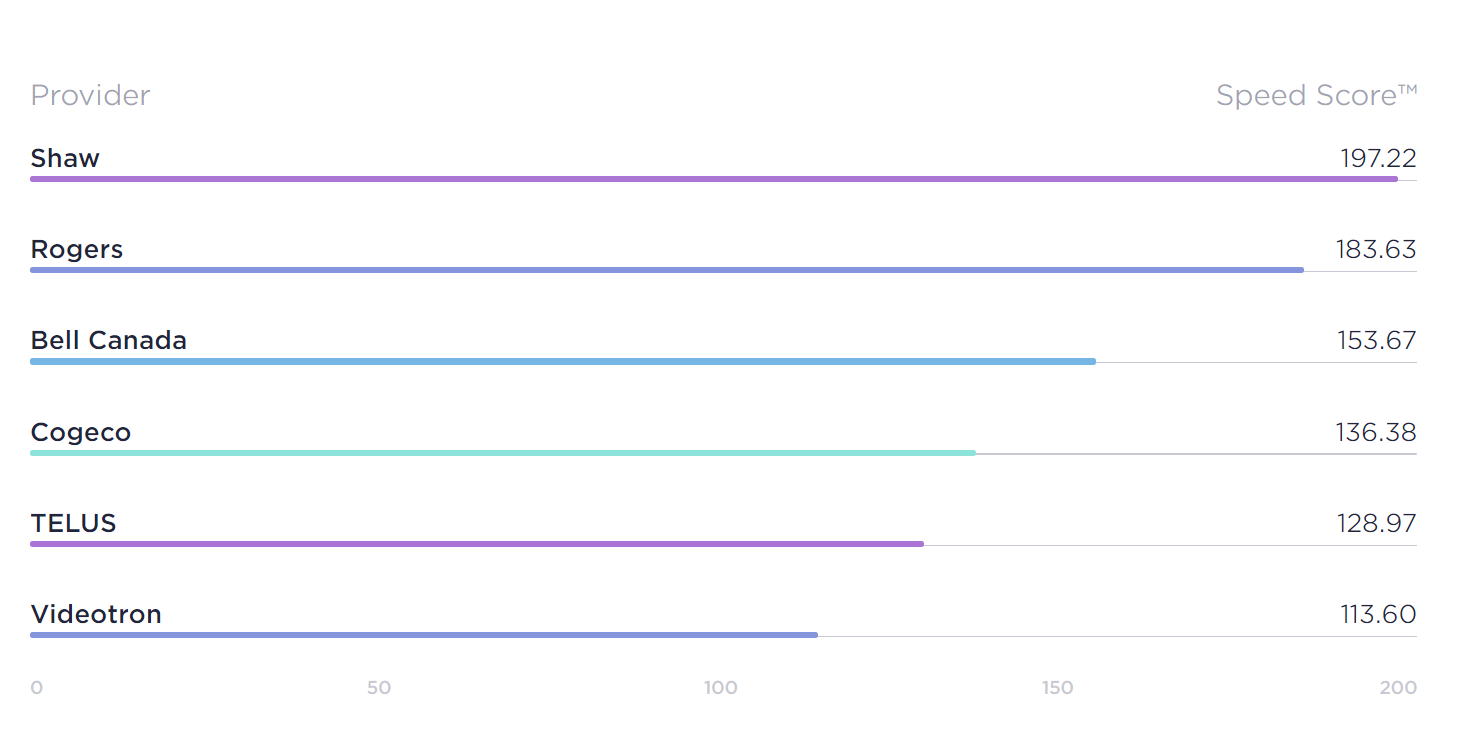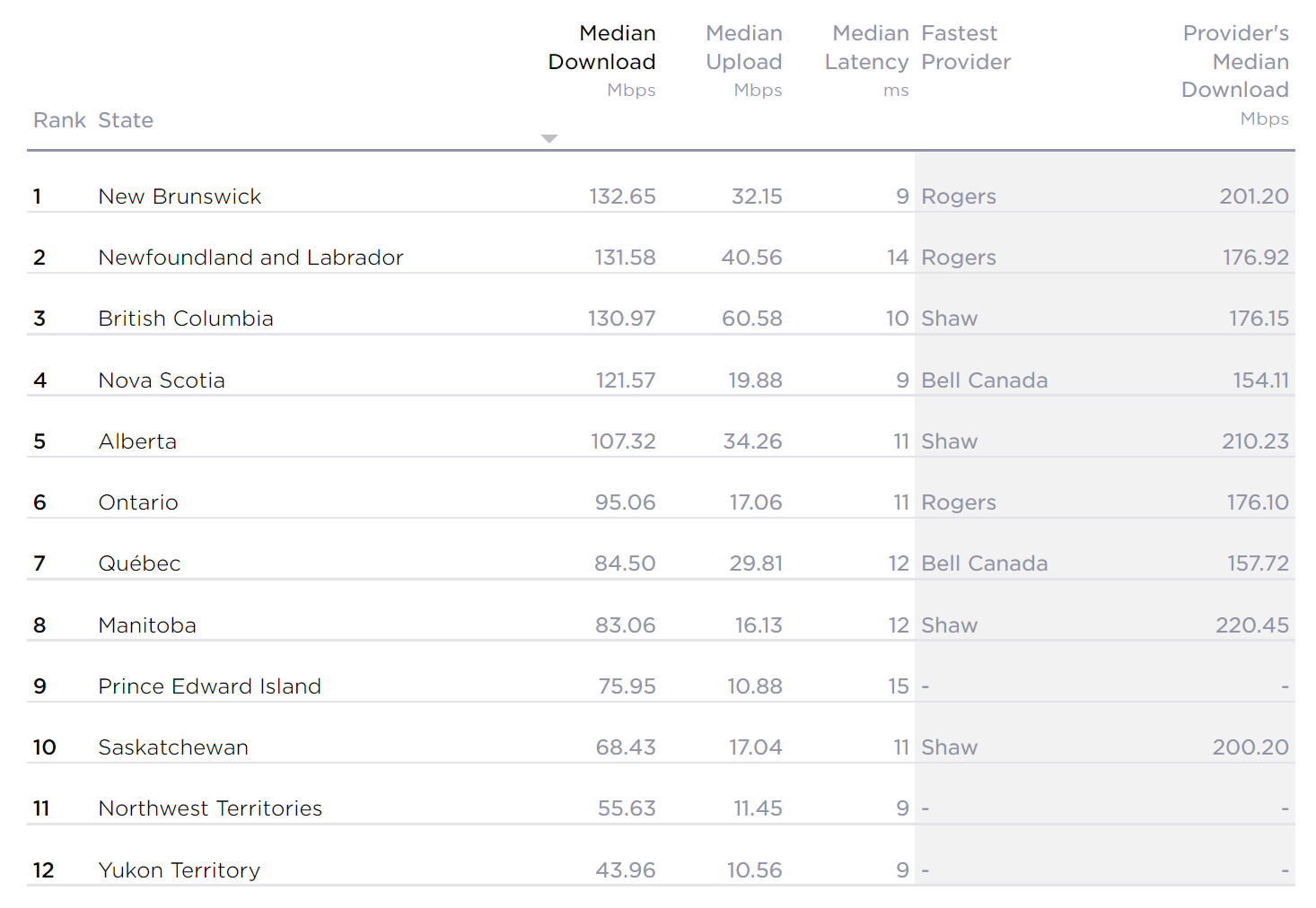Canada’s fixed broadband speeds jumped by 27 per cent in 2021, and mobile network download speeds increased by 15 per cent since July, says Ookla’s Canada Mobile and Fixed Broadband Internet Speeds report for Q4 2021.
Fixed broadband
According to Ookla‘s report, Canada’s median broadband download speed rose from 78.25 Mbps in January to 99.76 Mbps in December 2021. The median upload speed also rose slightly from 16.28 Mbps to 21.69 Mbps.

The Ookla report requires at least 300 unique user results from a country in order to be considered valid. The report ranks service providers using Ookla’s derived metrics such as Speed Score and Consistency Score.
West coast service provider Shaw Communications held the top spot through 2021 for the fastest median fixed broadband speeds. It ended the year with a Speed Score of 197.22, which is weighted for 80 per cent download and 20 per cent upload speeds. Rogers was a close second at 183.63 and Bell in third at 153.67. Telus, achieving a score of 128.97, was slightly outpaced by Cogeco which scored 136.38.
All of Canada’s major broadband providers had excellent latency. Bell had the lowest at 5ms, but even Cogeco, the worst performer on the list, only had 14ms.
Ookla calculates the consistency score by counting the percentage of submitted sample data that are above a minimum threshold. For broadband and 5G, it sets the baseline performance at 25Mbps download and 3Mbps upload.
Rogers bested Shaw by a hairbreadth as the most consistent broadband provider with an 89 per cent consistency score. Shaw came in a close second at 87.7 per cent. Bell and Telus ranked the bottom two at 82.5 and 81.9 per cent respectively, trailing Cogeco and Videotron, which scored 86.8 and 85.5 per cent.
In 2021, Newfoundland and Labrador, New Brunswick and British Columbia vied for the broadband speed crown. When the year ended, New Brunswick jumped up two spots and became the province with the highest medium broadband download speeds in Q4 2021. At 132.65Mbps, it’s just slightly faster than last quarter’s winner, Newfoundland and Labrador, which measured 131.58 Mbps in Q4. British Columbia ranked third at 130.97 Mbps, and Ontario remained in the sixth spot at 95.06Mbps.

The median download speeds in the Yukon and Northwest Territories were practically unchanged since the beginning of the year. In the Northwest Territories, download speed increased from 47.85 Mbps to 55.63Mbps between Q1 and Q4. The speeds in Yukon remained identical to Q1 with a median download speed of 43.96 Mbps.
Mobile
Canada’s median mobile download speeds increased by 10 per cent to 75.32 Mbps between January and December 2021, nudging it up to 15th place in Ookla’s global mobile network performance rankings.

Telus held the top spot throughout 2021 and emerged as the fastest mobile provider in Canada with a median download speed of 98.29 Mbps. Its lead is followed by Bell at 92.78 Mbps and Rogers at 72.65 Mbps. Fido, Rogers’ flanker brand, finished fourth place with performance just behind its flagship brand at 69.74Mbps, while Videotron and Freedom Mobile came in at 58.26 Mbps and 43.83 Mbps.
Looking at 5G performance alone, Bell and Telus essentially tied for first place with 171.39 Mbps and 167.74 Mbps median download speeds respectively. Rogers trailed significantly in this metric with just 109.42 Mbps.
These speeds actually are moderately slower than those in Ookla’s Q1 report. In Q1 2021, Bell was first with a median download speed of 212.08 Mbps, Telus was at 208.61 Mbps, and Rogers’ 5G network measured 131.89 Mbps.

The availability of 5G networks has increased this year. Rogers’ 5G network availability increased by 43 per cent, Telus 5G availability increased by 106 per cent, and Bell saw the largest increase with a whopping 136 per cent.
In addition to network expansions, the adoption of smartphones with 5G capabilities and plan upgrades also contributed to the rise in availability.
As for the devices with the fastest overall connectivity (4G and 5G), the top three spots all belonged to Apple. The iPhone 13 Pro Max, iPhone 13 Pro and the iPhone 13 demonstrated the best median download performance and lowest latency, followed by Samsung’s Galaxy S21+ 5G and Galaxy S21 Ultra 5G. With that said, in terms of combined performance, phones made by Google (not Android phones collectively) beat both Apple and Samsung in median download speeds.
Find the full breakdown of Ookla’s testing methodologies here.
